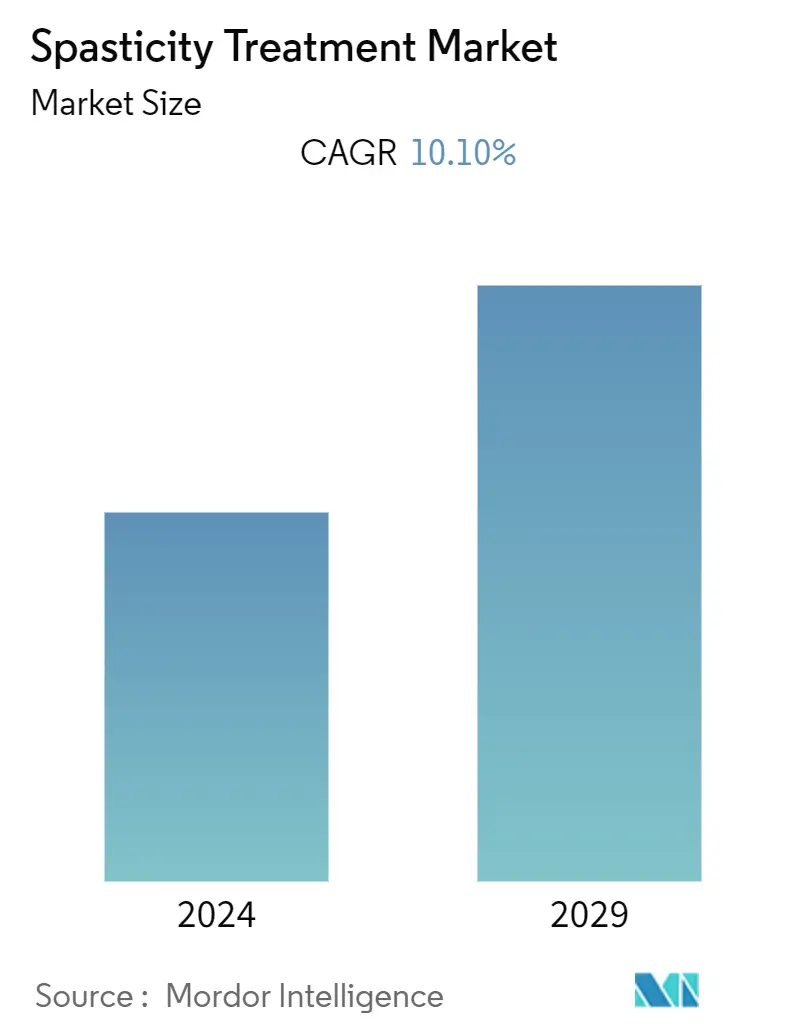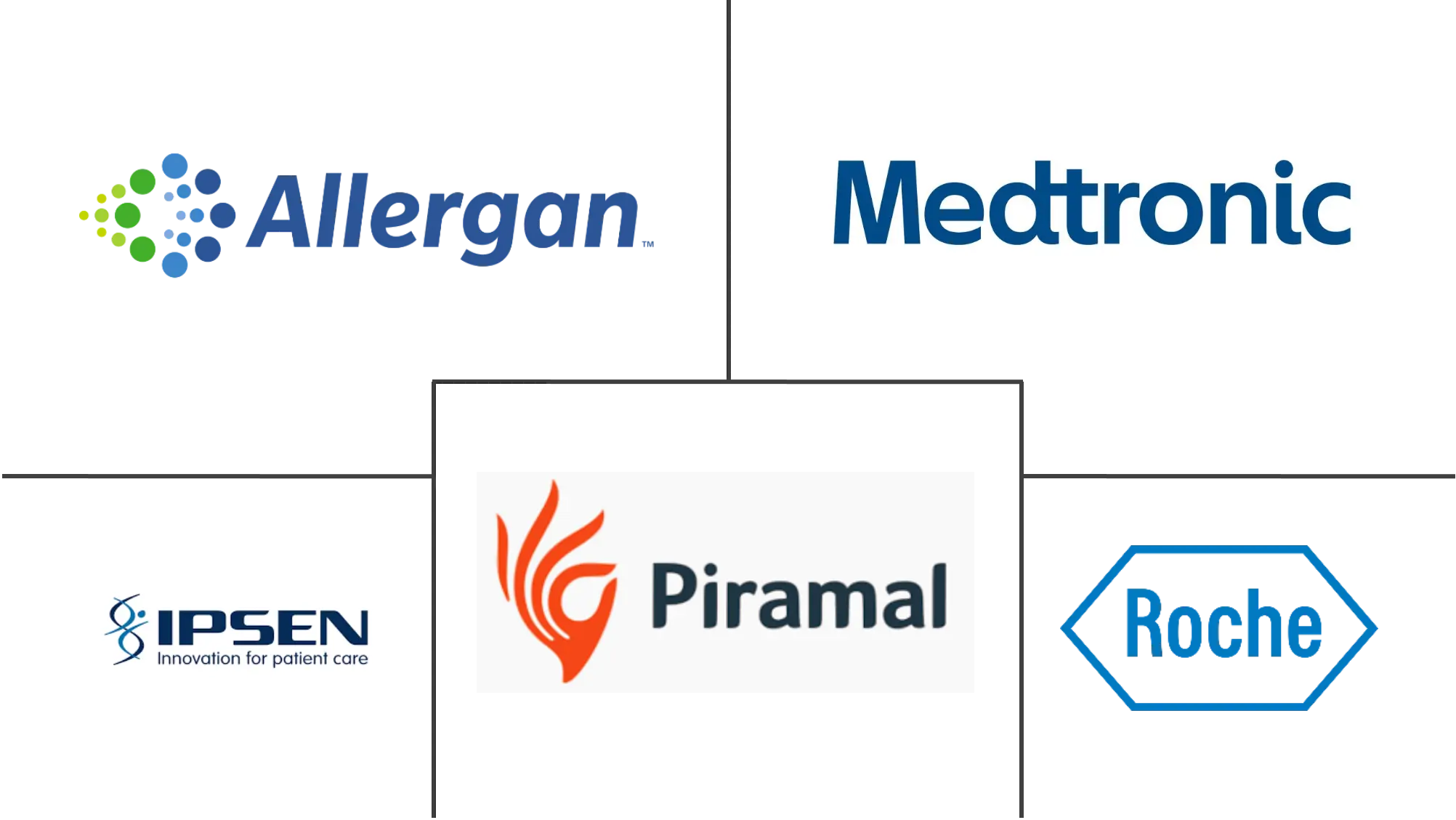Market Size of Spasticity Treatment Industry

| Study Period | 2019 - 2029 |
| Base Year For Estimation | 2023 |
| Forecast Data Period | 2024 - 2029 |
| CAGR (2024 - 2029) | 10.10 % |
| Fastest Growing Market | Asia Pacific |
| Largest Market | North America |
Major Players
*Disclaimer: Major Players sorted in no particular order |
Spasticity Drugs Market Analysis
The Spasticity Treatment Market is expected to register a CAGR of 10.10% during the forecast period.
The spasticity Treatment market studied was anticipated to grow with a CAGR of nearly 10.1% during the forecast period. The major factors attributing to the growth of the market are a rise in prevalence of multiple sclerosis, cerebral palsy, and encephalitis across the geographical locations compared to previous years. For instance, according to fact sheet published by The American Association of Neurological Surgeons in 2020, more than an estimated 12 million cases of spasticity were recorded worldwide. Also, cerebral palsy (CP) was identified as the leading cause of spasticity affecting more than 80 percent of people with the disorder demanding an efficient treatment driving the growth of the global spasticity drugs market.
Spasticity Drugs Industry Segmentation
Spasticity is a physiological condition in which contraction of muscles occurs continuously leading to tightening of muscles and prolonged stiffness. The spasticity may occur due to various disorders such as multiple sclerosis, meningitis, and other conditions such as injury to the spinal cord and others. Uncontrollable spasms in legs and arms are the common symptoms, along with frequent joint pain and lower back pains. Rise in spasticity cases among rare and genetic diseases such as Amyotrophic lateral sclerosis (ALS), phenylketonuria (PKU), which leads to the death of neurons controlling voluntary muscles is also expected to drive the market.
| Drug Class | |
| GABA Agonist | |
| Alpha2-adrenergic Agonists | |
| Botulinum Toxins | |
| Others |
| Indication | |
| Multiple Sclerosis (MS) | |
| Cerebral Palsy (CP) | |
| Traumatic Brain Injury (TBI) | |
| Others |
| Route of Administration | |
| Oral | |
| Parenteral |
| End-user | |
| Pediatrics | |
| Adults |
| Geography | ||||||||
| ||||||||
| ||||||||
| ||||||||
| ||||||||
|
Spasticity Treatment Market Size Summary
The spasticity treatment market is poised for significant growth, driven by the increasing prevalence of conditions such as multiple sclerosis, cerebral palsy, and encephalitis. These conditions have led to a rising demand for effective treatments, with cerebral palsy being a major contributor to spasticity cases globally. The market is characterized by the dominance of the oral route segment, which is favored for its ease of administration and the growing demand for combination products. North America is expected to lead the market, supported by a high incidence of traumatic brain injuries and a growing elderly population. The region benefits from advanced healthcare infrastructure and initiatives to raise health awareness, further propelling market growth.
The competitive landscape of the spasticity treatment market features several key players actively developing new products to meet unmet medical needs. Companies like Medtronic Plc, Piramal Enterprises Ltd, Allergan plc, Ipsen, and F. Hoffmann-La Roche Ltd are at the forefront, with recent product approvals enhancing their market positions. The approval of Dysport in the UK and the expanded use of XEOMIN in the United States highlight the ongoing innovation and regulatory support in the industry. These developments, coupled with the strategic initiatives by major players, are expected to drive the market's expansion over the forecast period.
Spasticity Treatment Market Size - Table of Contents
-
1. MARKET DYNAMICS
-
1.1 Market Overview
-
1.2 Market Drivers
-
1.2.1 Rise in Awareness Programs and Adoption of Novel Technologies
-
1.2.2 Launch of Advanced Therapeutics, and Increased Affordability
-
-
1.3 Market Restraints
-
1.3.1 High Cost of Treatment
-
1.3.2 Stringent Regulatory Framework
-
-
1.4 Porter's Five Force Analysis
-
1.4.1 Threat of New Entrants
-
1.4.2 Bargaining Power of Buyers/Consumers
-
1.4.3 Bargaining Power of Suppliers
-
1.4.4 Threat of Substitute Products
-
1.4.5 Intensity of Competitive Rivalry
-
-
-
2. MARKET SEGMENTATION
-
2.1 Drug Class
-
2.1.1 GABA Agonist
-
2.1.2 Alpha2-adrenergic Agonists
-
2.1.3 Botulinum Toxins
-
2.1.4 Others
-
-
2.2 Indication
-
2.2.1 Multiple Sclerosis (MS)
-
2.2.2 Cerebral Palsy (CP)
-
2.2.3 Traumatic Brain Injury (TBI)
-
2.2.4 Others
-
-
2.3 Route of Administration
-
2.3.1 Oral
-
2.3.2 Parenteral
-
-
2.4 End-user
-
2.4.1 Pediatrics
-
2.4.2 Adults
-
-
2.5 Geography
-
2.5.1 North America
-
2.5.1.1 United States
-
2.5.1.2 Canada
-
2.5.1.3 Mexico
-
-
2.5.2 Europe
-
2.5.2.1 Germany
-
2.5.2.2 United Kingdom
-
2.5.2.3 France
-
2.5.2.4 Italy
-
2.5.2.5 Spain
-
2.5.2.6 Rest of Europe
-
-
2.5.3 Asia Pacific
-
2.5.3.1 China
-
2.5.3.2 Japan
-
2.5.3.3 India
-
2.5.3.4 Australia
-
2.5.3.5 South Korea
-
2.5.3.6 Rest of Asia-Pacific
-
-
2.5.4 Middle East and Africa
-
2.5.4.1 GCC
-
2.5.4.2 South Africa
-
2.5.4.3 Rest of Middle East and Africa
-
-
2.5.5 South America
-
2.5.5.1 Brazil
-
2.5.5.2 Argentina
-
2.5.5.3 Rest of South America
-
-
-
Spasticity Treatment Market Size FAQs
What is the current Spasticity Treatment Market size?
The Spasticity Treatment Market is projected to register a CAGR of 10.10% during the forecast period (2024-2029)
Who are the key players in Spasticity Treatment Market?
Medtronic Plc, Piramal Enterprises Ltd, Allergan plc, Ipsen and F. Hoffmann-La Roche Ltd are the major companies operating in the Spasticity Treatment Market.

